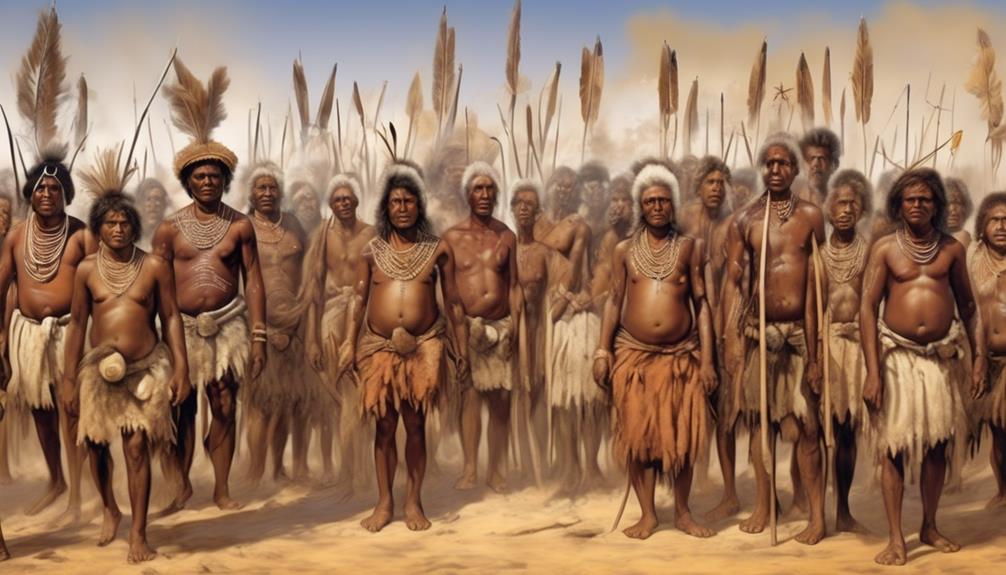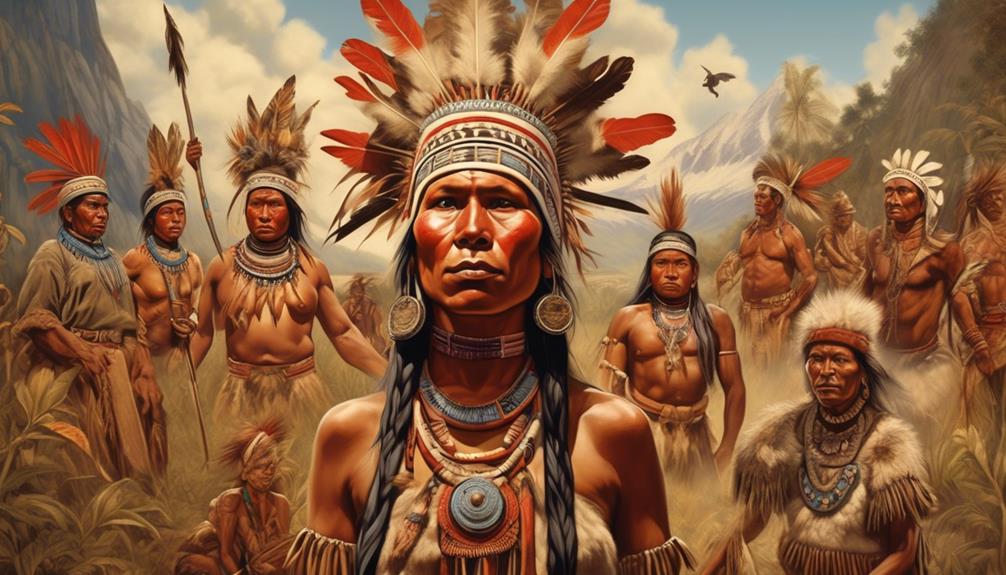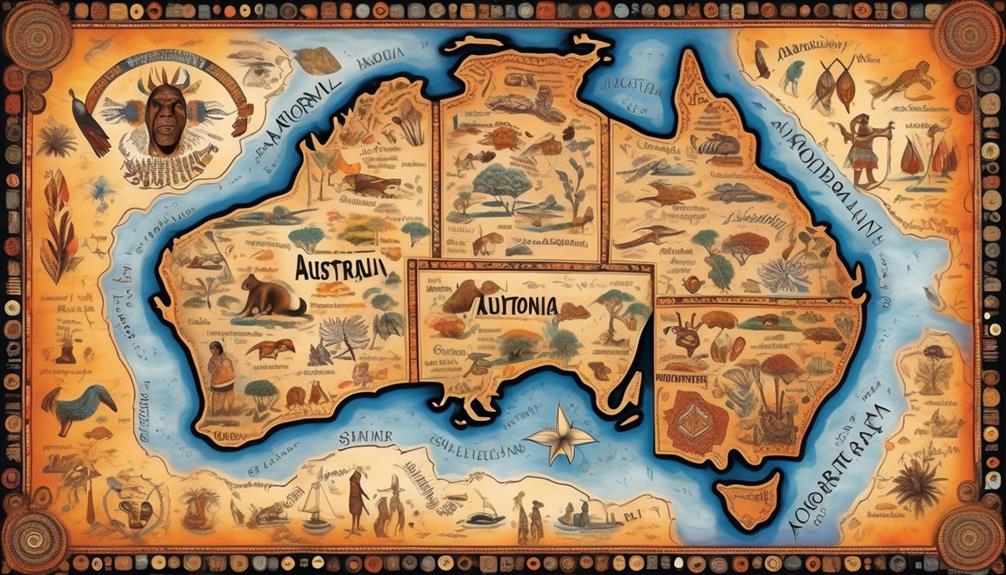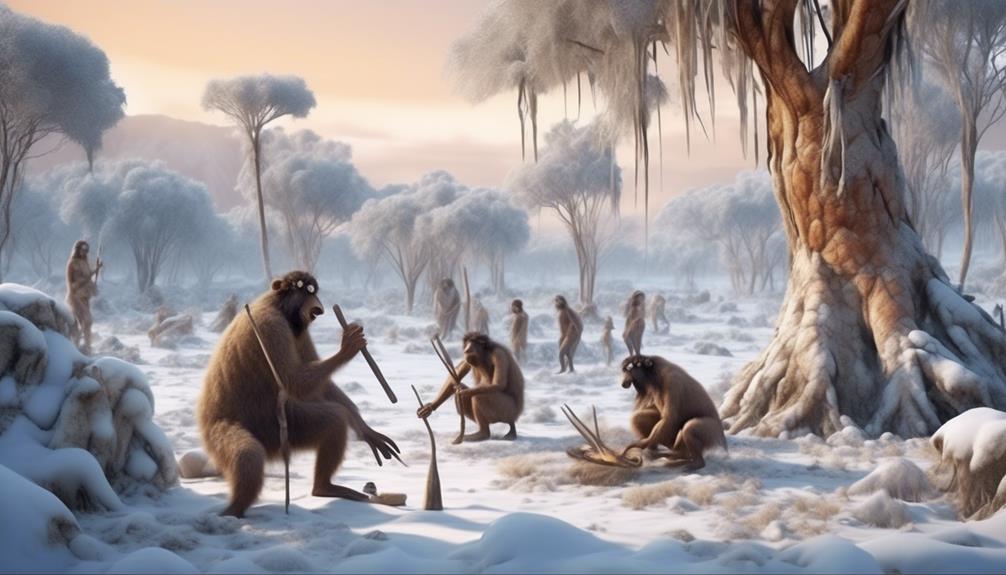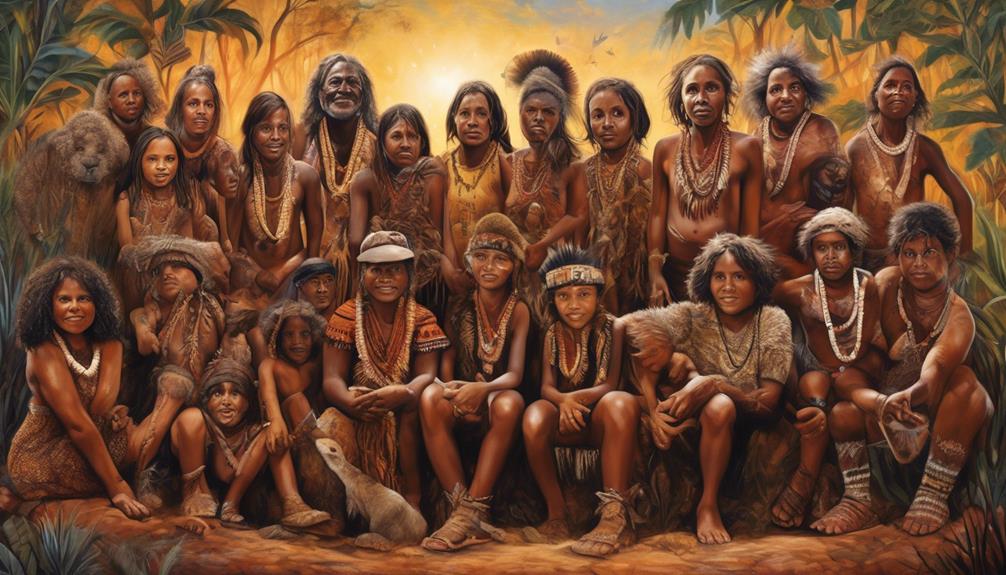When Europeans arrived in 1788, the way of life for Indigenous Australians changed dramatically. Like a tree caught in an uncontrollable wildfire, the impact of European colonization spread through their communities, leaving lasting scars that still linger today.
But what was the true extent of this impact, and how did it shape the future of Aboriginal Australians? We will explore the intricate web of historical events and their profound effects on the indigenous population, shedding light on a chapter of history often overlooked or misunderstood.
Key Takeaways
- Arrival of European settlers introduced new diseases, causing devastating consequences for the Aboriginal population due to their lack of immunity.
- Violent conflicts and confrontations over territory and cultural differences resulted in loss of life and ongoing trauma.
- Government policies of forced assimilation and the 'Stolen Generations' had devastating effects, including emotional trauma, cultural loss, and displacement.
- Dispossession of traditional lands, loss of resources, and erosion of traditional knowledge had profound socioeconomic and cultural impacts on Aboriginal communities.
Impact of New Diseases
Upon the arrival of European settlers in 1788, the impact of new diseases on the population of Aboriginal Australians was significant and led to a drastic decline in their numbers. The introduction of diseases such as smallpox, influenza, measles, and tuberculosis, to which the Indigenous population had little to no immunity, resulted in devastating consequences.
The impact of colonization brought about healthcare disparities, as the Aboriginal Australians had vastly different medical practices and remedies, which weren't equipped to combat the new diseases introduced by the Europeans. This led to a severe imbalance in healthcare access and outcomes, further exacerbating the detrimental effects of the new diseases.
The lack of immunity, coupled with inadequate healthcare resources, contributed to a rapid decline in the Aboriginal population. This historical context underscores the critical need for equitable healthcare systems and culturally competent medical practices to address the enduring impacts of colonization on the health and well-being of Aboriginal Australians.
Understanding this impact is crucial for developing strategies to address current healthcare disparities and improve the overall health outcomes for Indigenous communities.
Violent Conflicts and Massacres

The devastating impact of new diseases on the population of Aboriginal Australians was compounded by the occurrence of violent conflicts and massacres, which further contributed to the decline of their numbers. These violent conflicts often arose from the expansion of European settlers into Aboriginal lands, leading to confrontations over territory, resources, and cultural differences. The repercussions of these conflicts were profound, resulting in significant loss of life, displacement, and trauma within Aboriginal communities.
The scars of these historical events continue to reverberate through generations, impacting the social and emotional well-being of Aboriginal Australians. Trauma and resilience: The enduring trauma from violent conflicts and massacres has tested the resilience of Aboriginal communities, shaping their collective experiences and challenging their ability to heal.
Intergenerational healing: The legacy of these violent events has necessitated a focus on intergenerational healing, as the trauma and its effects have been passed down through successive generations, impacting cultural identity and community cohesion.
Understanding the ongoing impact of violent conflicts and massacres is crucial in addressing the historical injustices and supporting the journey towards healing and reconciliation for Aboriginal Australians.
Forced Relocations and Displacement
Following European arrival in 1788, forced relocations and displacement significantly impacted the lives and communities of Aboriginal Australians. The government's policies of forced assimilation and the implementation of the "Stolen Generations" had devastating effects on Aboriginal families and communities. The forced removal of Aboriginal children from their families and communities not only caused deep emotional trauma and loss but also disrupted the transmission of cultural knowledge and practices, further contributing to the disintegration of traditional Aboriginal societies.
| Forced Relocations and Displacement | Impact on Aboriginal Communities |
|---|---|
| Forced Assimilation | Disruption of cultural continuity and identity |
| Stolen Generations | Emotional trauma and loss of cultural heritage |
| Loss of connection to land | Displacement from traditional lands and spiritual connection |
The policies of forced assimilation and the removal of children from their families led to severe social and psychological consequences, including the loss of cultural identity and knowledge. The forced displacement from traditional lands also resulted in a loss of connection to spiritual and cultural practices, further exacerbating the challenges faced by Aboriginal communities. These historical injustices continue to have a profound impact on the lives of Aboriginal Australians today.
Loss of Traditional Lands and Resources
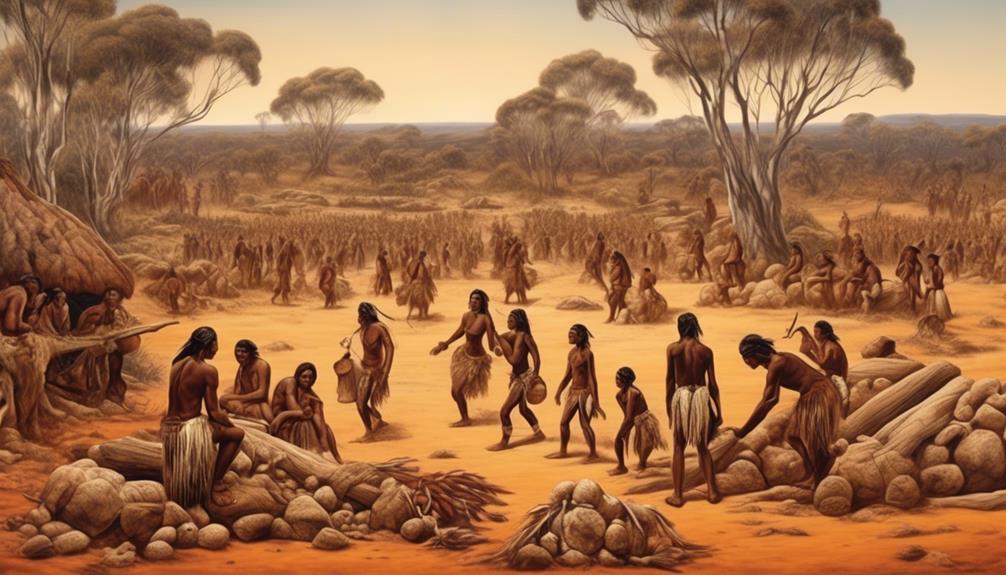
After European arrival in 1788, the loss of traditional lands and resources profoundly impacted the socioeconomic and cultural resilience of Aboriginal communities. Dispossession and environmental degradation have been significant factors contributing to this impact.
- Loss of Connection to Country: The dispossession of traditional lands severed the deep spiritual and cultural connection Aboriginal people had with their ancestral territories, leading to a loss of identity and cultural practices.
- Impact on Livelihood: The loss of traditional lands and resources directly affected the ability of Aboriginal communities to sustain their traditional livelihoods, such as hunting, gathering, and agriculture, leading to economic challenges and food insecurity.
- Health and Well-being: Dispossession and environmental degradation have contributed to a decline in the physical and mental well-being of Aboriginal peoples, as they struggle to access traditional medicinal plants and maintain their holistic connection to the land.
- Cultural Erosion: The loss of traditional lands and resources has resulted in the erosion of traditional knowledge, languages, and cultural practices, impacting the overall resilience and cohesion of Aboriginal communities.
These interconnected impacts have been profound, shaping the ongoing challenges faced by Aboriginal communities in Australia today.
Cultural Disruption and Social Disintegration
Experiencing cultural disruption and social disintegration, Aboriginal communities have encountered formidable challenges in maintaining their traditional practices and societal cohesion since the arrival of European settlers in 1788. The erosion of cultural practices and the loss of language have contributed to an identity crisis and generational trauma among Aboriginal Australians. This has led to a profound impact on their social fabric and traditional way of life.
| Challenges Faced | Impact on Communities |
|---|---|
| Erosion of cultural practices | Loss of traditional knowledge and skills |
| Language loss | Communication barriers, hindering cultural transmission |
| Identity crisis | Struggle to maintain a cohesive cultural identity |
| Generational trauma | Lingering psychological effects of historical trauma |
| Disintegration of social structures | Breakdown of traditional kinship and societal roles |
The erosion of cultural practices has resulted in the loss of traditional knowledge and skills, affecting the transmission of cultural practices from one generation to another. Language loss has created communication barriers, hindering the preservation and transmission of cultural heritage. This has led to an identity crisis and generational trauma, impacting the psychological well-being of the community. Additionally, the disintegration of social structures has led to a breakdown of traditional kinship and societal roles, further exacerbating the challenges faced by Aboriginal communities.
Frequently Asked Questions
How Did the Arrival of Europeans in 1788 Affect the Spiritual Beliefs and Practices of Aboriginal Australians?
We saw a significant impact on the spiritual beliefs and cultural practices of Aboriginal Australians after the arrival of Europeans in 1788.
The introduction of Christianity and forced assimilation policies led to a disruption of traditional beliefs and practices. Many sacred sites were desecrated, and ceremonial practices were suppressed.
This cultural upheaval caused significant trauma and loss for Aboriginal communities, leading to a complex and ongoing struggle to preserve and revitalize their spiritual traditions and cultural practices.
What Role Did the Introduction of Alcohol and Other Addictive Substances Play in the Decline of the Aboriginal Population After European Arrival?
In understanding the impact of addiction on the decline of the Aboriginal population, we analyze the intertwining of historical factors and cultural resilience.
The introduction of alcohol and addictive substances had devastating consequences, disrupting traditional social structures and health. This, compounded by other European influences, led to a decline in population.
It's crucial to recognize and honor the strength and survival of Aboriginal culture amidst these challenges.
How Did the Arrival of Europeans Impact the Traditional Roles and Status of Aboriginal Women Within Their Communities?
The arrival of Europeans significantly impacted the traditional roles and status of Aboriginal women within their communities. It affected family dynamics and community leadership, leading to shifts in power structures and social norms.
These changes were a result of European colonization and the imposition of their cultural values and systems. The impact on family and community leadership was profound, altering the fabric of Aboriginal society and challenging established gender roles and responsibilities.
What Were the Long-Term Effects of the Loss of Traditional Hunting and Gathering Grounds on the Physical Health and Well-Being of Aboriginal Australians?
Losing traditional hunting and gathering grounds drastically impacted the physical health and cultural well-being of Aboriginal Australians. The disruption led to malnutrition, loss of traditional healing practices, and a decline in mental well-being.
This loss of connection to the land has had long-term effects on their physical health and cultural identity.
Despite these challenges, the resilience and strength of Aboriginal communities continue to drive efforts towards reclaiming their well-being and traditions.
How Did the Forced Removal of Aboriginal Children From Their Families and Communities Affect the Continuation of Cultural Knowledge and Practices?
Forced removal of Aboriginal children from families and communities had a profound impact on identity and caused community disintegration. This led to the loss of cultural knowledge and practices, disrupting the transmission of traditions across generations.
Research shows that this systematic disruption had detrimental effects on the maintenance of Aboriginal culture and contributed to a sense of disconnection and loss within the community. Such practices had long-lasting repercussions on the Aboriginal population.
Conclusion
In the wake of European arrival in 1788, the population of Aboriginal Australians experienced devastating impacts. This included the introduction of new diseases, violent conflicts, forced relocations, loss of traditional lands and resources, and cultural disruption.
This collective trauma serves as a dark shadow over the history of Australia, casting a long and haunting legacy that continues to impact the Aboriginal population to this day. The scars of the past still linger, reminding us of the enduring struggle for justice and reconciliation.
Mary is a passionate writer who brings creativity and a fresh perspective to our team. Her words have the power to captivate and inspire, making her an essential contributor to our content. Mary’s commitment to storytelling and dedication to promoting Indigenous culture ensures that her work touches the hearts of our readers. We’re fortunate to have her as part of our team.
